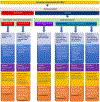Towards health-based nano reference values (HNRVs) for occupational exposure: Recommendations from an expert panel
- PMID: 35560294
- PMCID: PMC10617652
- DOI: 10.1016/j.impact.2022.100396
Towards health-based nano reference values (HNRVs) for occupational exposure: Recommendations from an expert panel
Abstract
Unique physicochemical characteristics of engineered nanomaterials (ENMs) suggest the need for nanomaterial-specific occupational exposure limits (OELs). Setting these limits remains a challenge. Therefore, the aim of this study was to set out a framework to evaluate the feasibility of deriving advisory health-based occupational limit values for groups of ENMs, based on scientific knowledge. We have used an expert panel approach to address three questions: 1) What ENM-categories should be distinguished to derive advisory health-based occupational limit values (or health-based Nano Reference Values, HNRVs) for groups of ENMs? 2) What evidence would be needed to define values for these categories? And 3) How much effort would it take to achieve this? The panel experts distinguished six possible categories of HNRVs: A) WHO-fiber-like high aspect ratio ENMs (HARNs), B) Non-WHO-fiber-like HARNs and other non-spheroidal ENMs, C) readily soluble spheroidal ENMs, D) biopersistent spheroidal ENMs with unknown toxicity, E) biopersistent spheroidal ENMs with substance-specific toxicity and F) biopersistent spheroidal ENMs with relatively low substance-specific toxicity. For category A, the WHO-fiber-like HARNs, agreement was reached on criteria defining this category and the approach of using health-based risk estimates for asbestos to derive the HNRV. For category B, a quite heterogeneous category, more toxicity data are needed to set an HNRV. For category C, readily soluble spheroidal ENMs, using the OEL of their molecular or ionic counterpart would be a good starting point. For the biopersistent ENMs with unknown toxicity, HNRVs cannot be applied as case-by-case testing is required. For the other biopersistent ENMs in category E and F, we make several recommendations that can facilitate the derivation of these HNRVs. The proposed categories and recommendations as outlined by this expert panel can serve as a reference point for derivation of HNRVs when health-based OELs for ENMs are not yet available.
Keywords: Engineered nanomaterials; Expert panel; Health based; Nano reference values; Occupational exposure limit.
Copyright © 2022 The Authors. Published by Elsevier B.V. All rights reserved.
Figures



Similar articles
-
Workshop report: strategies for setting occupational exposure limits for engineered nanomaterials.Regul Toxicol Pharmacol. 2014 Apr;68(3):305-11. doi: 10.1016/j.yrtph.2014.01.005. Epub 2014 Jan 23. Regul Toxicol Pharmacol. 2014. PMID: 24462629
-
Characterizing risk assessments for the development of occupational exposure limits for engineered nanomaterials.Regul Toxicol Pharmacol. 2018 Jun;95:207-219. doi: 10.1016/j.yrtph.2018.03.018. Epub 2018 Mar 21. Regul Toxicol Pharmacol. 2018. PMID: 29574195 Free PMC article. Review.
-
International landscape of limits and recommendations for occupational exposure to engineered nanomaterials.Toxicol Lett. 2020 Apr 1;322:111-119. doi: 10.1016/j.toxlet.2020.01.016. Epub 2020 Jan 22. Toxicol Lett. 2020. PMID: 31981686 Review.
-
In silico analysis of nanomaterials hazard and risk.Acc Chem Res. 2013 Mar 19;46(3):802-12. doi: 10.1021/ar300049e. Epub 2012 Nov 8. Acc Chem Res. 2013. PMID: 23138971
-
Achieving Control of Occupational Exposures to Engineered Nanomaterials.J Occup Environ Hyg. 2015;12(8):501-8. doi: 10.1080/15459624.2015.1011329. J Occup Environ Hyg. 2015. PMID: 25635953
Cited by
-
Meta-Analysis of Integrated Proteomic and Transcriptomic Data Discerns Structure-Activity Relationship of Carbon Materials with Different Morphologies.Adv Sci (Weinh). 2024 Mar;11(9):e2306268. doi: 10.1002/advs.202306268. Epub 2023 Dec 20. Adv Sci (Weinh). 2024. PMID: 38116877 Free PMC article.
-
Occupational Exposure during the Production and the Spray Deposition of Graphene Nanoplatelets-Based Polymeric Coatings.Nanomaterials (Basel). 2023 Apr 15;13(8):1378. doi: 10.3390/nano13081378. Nanomaterials (Basel). 2023. PMID: 37110963 Free PMC article.
-
Spatiotemporal Mapping of Ultrafine Particle Fluxes in an Office HVAC System with a Diffusion Charger Sensor Array.ACS EST Air. 2024 Dec 17;2(1):49-63. doi: 10.1021/acsestair.4c00140. eCollection 2025 Jan 10. ACS EST Air. 2024. PMID: 39817256 Free PMC article.
-
Techniques and Instruments for Assessing and Reducing Risk of Exposure to Nanomaterials in Construction, Focusing on Fire-Resistant Insulation Panels Containing Nanoclay.Nanomaterials (Basel). 2024 Sep 10;14(18):1470. doi: 10.3390/nano14181470. Nanomaterials (Basel). 2024. PMID: 39330628 Free PMC article.
-
Integrating Exposure Assessment and Process Hazard Analysis: The Nano-Enabled 3D Printing Filament Extrusion Case.Polymers (Basel). 2023 Jun 27;15(13):2836. doi: 10.3390/polym15132836. Polymers (Basel). 2023. PMID: 37447482 Free PMC article.
References
-
- ACGIH, 2015. TLVs and BEIs. In: Based on the Documentation of the Threshold Limit Values for Chemical Substances and Physical Agents & Biological Exposure Indices Cincinnati, USA. ISBN: 978–1-607260–77-6.
-
- AGS, 2016. BekGS 527 - Hergestellte Nanomaterialien. In: GMBl 2016 S. 754–767 [Nr. 38]. AGS edited by Ausschuss für Gefahrstoffe. https://www.baua.de/DE/Angebote/Rechtstexte-und-Technische-Regeln/Regelw....
-
- ANSES, 2020. Valeurs limites d’exposition en milieu professionnel. Le dioxyde de titane sous forme nanométrique (TiO2-NP, P25). In: Maisons-Alfort cedex, La France: de l’Agence nationale de sécurité sanitaire de l’alimentation, de l’environnement et du travail. https://www.anses.fr/fr/system/files/VSR2019SA0109Ra.pdf.
-
- Arts JH, Hadi M, Irfan MA, Keene AM, Kreiling R, Lyon D, Maier M, Michel K, Petry T, Sauer UG, Warheit D, Wiench K, Wohlleben W, Landsiedel R, 2015. A decision-making framework for the grouping and testing of nanomaterials (DF4nanoGrouping). Regul. Toxicol. Pharmacol. 71, S1–27. 10.1016/j.yrtph.2015.03.007. - DOI - PubMed
-
- Baron PA, 2016. Measurement of fibers. In: NIOSH Manual of Analytical Methods. U.S. Department of Health and Human Services, Centers for Disease Control and Prevention, National Institute for Occupational Safety and Health, DHHS (NIOSH): NISOH. https://www.cdc.gov/niosh/docs/2014-151/pdfs/chapters/chapter-fi.pdf.
Publication types
MeSH terms
Substances
Grants and funding
LinkOut - more resources
Full Text Sources
Medical

